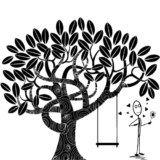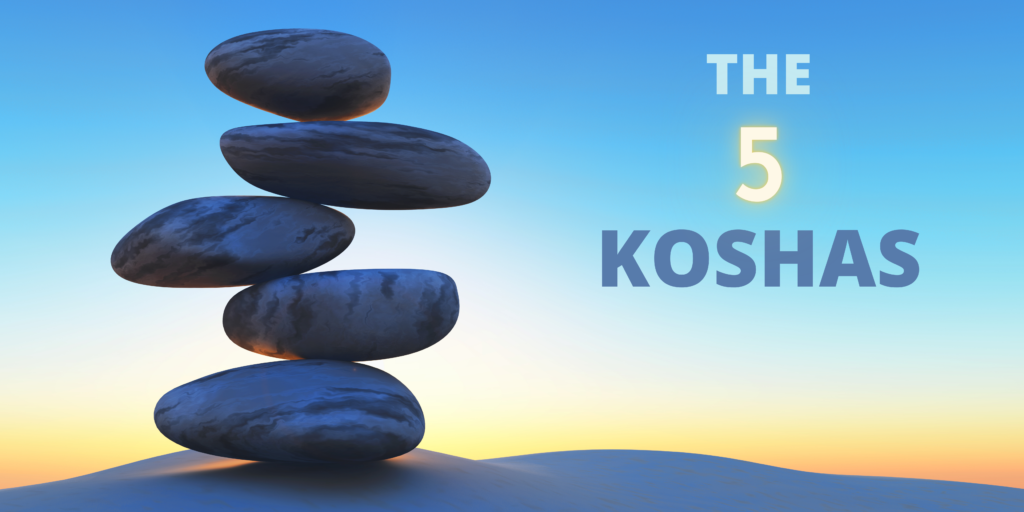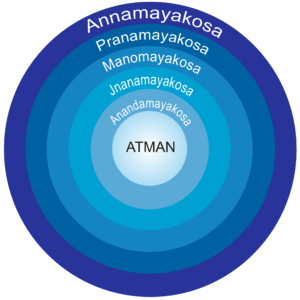According to Eastern philosophy, you are a multi-layered being, with physical and subtle bliss bodies. The koshas are the energy layers of your body that surround and protect your soul. They are the metaphorical layers that make up the human body, mind, and soul.
History and Philosophy
They are known as the 5 casings that keep the light, purity, and perfection of your true self and were originally described in the ancient yogic scripture, the Taittiriya Upanishad. This Vedic treatise, estimated to have been composed in the 6th century B.C., contains spiritual liberation principles. Some feel that the koshas are essential for increasing awareness of your inner world and connecting your mind, body, and spirit. Paying attention to your koshas may help you reach greater levels of awareness on your road to self-realization. The Taittiriya Upanishad also describes how to build character and behave properly. These ways of life are guides on the route to achieving Brahma Jnana, or awareness of your supreme self.
The meaning of Kosha is derived from the Upanishads, ancient Vedic scriptures that influenced Hinduism and many parts of yoga philosophy. In Sanskrit, kosha means “sheath.” The 5 sheaths give a framework for comprehending the deepest self, or Atman, which is Sanskrit for the spirit or soul, according to ancient Vedantic philosophy. The 5 koshas co-exist and are encased, or nested, inside one another. The outermost layer is made up of your physical body, while the deepest layer is made up of your bliss body or soul.
The physical, tangible body is merely your exterior self, like your clothing. By removing this layer, you may reveal a somewhat more subtle layer—the pranic body. The mental body is the next layer inward, followed by the intellectual body, and lastly, the bliss body. The self, or Atman, is the deepest core. Starting from the outermost layer and moving through the layers to the core of the self, each body is made up of increasingly subtler degrees of energy—from the physical body, to the energetic body, to the mental body, to the wisdom body, and finally, to the bliss body.
Yoga practises may help you transcend each sheath. As you go through the sheaths, you cease identifying with these layers, whether they be the body, mind, or intellect, and you begin to know that your true self exists beyond these 5 layers.
Understanding one’s own levels of being is essential to attain joy and success in life. If you don’t realize your inner self, you’ll always be on the surface, subject to your wants and an illusory perception of the world.
The Koshas (Five Koshas)
As we explore the koshas below, you’ll note that they map out an inner trip, beginning at the body’s periphery and ending at the very core of who you are.
Annamaya Kosha (The Food Shealth)
The Annamaya Kosha, also known as the Food Sheath, is the body’s outermost layer. It is what is palpable and visible. It is made up of the same five elements as everything else in nature—earth, water, fire, air, and space.
Because the Annamaya Kosha is made up of digested and transformed food, it translates to the food sheath. It will also return as food for other plants and animals after death.
This is the weakest of the 5 sheaths. Any joy experienced at this level is transitory and has a short lifespan. This sheath, in yogic terminology, may be overcome via asanas.
Pranamaya Kosha (The Vital Sheath)
The Vital Sheath is translated as the Pranamaya Kosha. It is finer than the food sheath and cannot be seen with the naked eye. This layer and its grosser counterpart, Annamaya Kosha, are where the human being manifests itself. It’s the breath, and the life that comes with it.
The Pranamaya Kosha is the barrier between life and death. Prana is the source of life, whereas a lack of prana denotes death. As a result, this kosha is inextricably linked to the Annamaya Kosha. The Annamaya Kosha will dissolve after prana has left the body.
This sheath is made up of 5 pranas (Prana, Udana, Vyana, Samana, and Apana) and 5 organs of action. The mouth, hands, feet, rectum, and genitals are the Karmendriyas.
Fresh and nutritious food, sunshine, and air nurture the Pranamaya Kosha. Through the practice of pranayama, yogis may transcend this sheath.
Manomaya Kosha (The Mental Sheath)
The Manomaya Kosha, or Mental Sheath, is the next layer. It is not just the mind, but also the subconscious and the 5 knowledge organs. The sense organs themselves are represented by these Jnana Indriyas—the eyes, nose, ears, tongue, and skin. The mind absorbs information via its sensory organs. Desires are also generated by these sensory organs.
Thoughts, emotions, feelings, imagination, memories, and the subconscious mind are all part of the Manomaya Kosha. An unruly mind may lead to detrimental choices, unpleasant emotions, and poor wellness decisions. It may be enhanced by following the Yamas and Niyamas, as well as doing Karma Yoga or selfless service.
Vijnanamaya Kosha (The Intellectual Sheath)
The Intellectual Sheath, or Vijnanamaya Kosha, is even more delicate than the mental sheath. It’s also known as the Wisdom/Knowledge Sheath.
This sheath is what differentiates man from animals. While both have memories, thoughts, sentiments, and emotions, only man can distinguish between what is good and bad, as well as between what is real and unreal.
The Vijnanamaya Kosha encompasses the ego as well as the intellect. It has a strong feeling of self and identity, as well as an I-am-ness. This kosha may be enhanced by doing Jnana Yoga or following the path of wisdom. Studying scriptures and spiritual writings, meditating, and asking the question “Who am I?” all help to build a true knowledge of oneself.
Anandamaya Kosha (The Bliss Sheath)
The ultimate inner sheath is the Anandamaya Kosha. It is the most subtle of all the personality layers. This layer contains the Vasanas, or hidden inclinations and wants in the personality. It carries the soul’s various experiences with it through its countless rebirths.
While this sheath provides a feeling of connection to the divine, the cycles of rebirth continue until this sheath is transcended. That transcendence is Samadhi, or self-realization. And, the Atman, or self, exists beyond all 5 sheats. It is most closely linked to you through the Anandamaya Kosha, but it also affects all 5 koshas.
This Pancha Kosha philosophy may help you figure out who you are. With this information, you may transcend the grosser layers of your existence, tuning in to the delicate components of your personality, improving your conduct, and eventually discovering your true self.
What is the Difference Between Koshas and Chakras?
While the koshas are thought to reside in layers of your body, with the bliss body at the core, the chakras are spiritual energy wheels that run down your spine.
Chakras, as well as nadis and kundalini, may be found in the astral body. Chakras, which connect the nadis to the sheaths, have an impact on your physical, mental, and emotional health.
Nadis are energy and essential life force pathways. There are hundreds of nadis in your body that affect your overall health. One of the important nadis is the Sushumna channel, which runs from your spine to the top of your head. Kundalini energy flows along the Sushumna Nadi and the 7 chakras when it is aroused at the base of your spine. The 7 chakras are energized when this magnificent cosmic energy wakes up and rises via the central channel.
Integrating the 5 Koshas
Each of the 5 levels of self is interrelated and reliant on the others. When the body is tense, the respiration is shallow, the mind is agitated, and wisdom and joy are lacking.
There is disharmony on all layers if there is a connection with the soul, suggesting a weak bliss body. Joy and tranquility, on the other hand, pervade all parts of who you are when you are totally in sync with your bliss body.
Yoga practice and philosophical application in our daily lives help bring all the koshas—body, breath, mind, wisdom, and spirit—into harmony, boosting general health and bringing you closer to self-realization and total wholeness of being.
Yoga for Koshas Integration
Understanding the 5 koshas might assist you in learning to detach from your identity or ego. Beginning with the outer levels, you will be guided to deeper realms of consciousness and pure happiness, called Samadhi. During a yoga session, you may connect with the koshas via asanas or postures. Here’s how it works:
- Become conscious of your physical body, both physically and inwardly, in each pose.
- Next, pay attention to how your breath affects your body and thoughts. Breathe into any regions that are tense or tight.
- Consider how you can use your breath to direct your movements.
- Determine if each movement should be timed to an inhalation or exhalation. If you’re not sure, try it both ways.
The koshas are used by yogic practitioners and spiritual searchers on the road of self-discovery to answer questions like “Who am I?” This meditation practice, also known as the straight way, is a Jnana Yoga teaching
The road of knowledge, self-realization, or insight refers to this approach of self-inquiry. Simply ask yourself this question and see what comes up.
You may also ask yourself what you would be like if you didn’t have certain thoughts or look into the roots of a certain concept.
Experiencing the 5 Koshas
The seven-step practice that follows will help you get a better understanding of these inner dimensions of your persona.
Sit relaxed with your head, neck, and trunk in line. Sit up straight and without straining. You’ll feel awake and calm at the same time.
- Close your eyes and focus your attention away from the sights and noises around you. Pay close attention to your physical body. Consider your head and shoulders, chest and waist, back and belly, and arms and legs. This is the Annamaya Kosha for you.
- Bring your whole focus to the space between your nostrils and breathe deeply. Your breath will gradually become more slow, smooth, and silent. Be mindful of the energy that flows through your body. It causes your heart to beat, your lungs to expand and contract, blood to flow through your veins, and your stomach to gurgle. Your Pranamaya Kosha is the energy orchestrating this movement, not your physical body.
- Bring your attention back to your brain. Pay attention to the portion of your consciousness that controls your sensory input and motor output. This is the portion of you that senses your nose itching and instructs your hand to scratch it. It notices that you’ve been sitting in the same posture for too long and wants you to move your legs. It causes the reflexive mental chatter that runs through your head all the time. This is your Manomaya Kosha.
- Raise your consciousness to a higher level inside your head. Feel the portion of your consciousness that intentionally chose to engage in this exercise and is now telling you to sit still and finish it. It understands the importance of increasing self-awareness and pushes you to wake up early in the morning to practice your hatha postures and meditation, even if lying in bed would be more comfortable. This is your Vijnanamaya Kosha.
- Concentrate your attention on your heart. Deeply relax; continue to breathe easily and evenly. Allow yourself as much time as you need to sink into a state of perfect tranquillity. A sensation of genuine delight is buried deep inside that inner tranquillity. This is not emotional bliss, but it may flow out of you as a feeling of immense pleasure and thankfulness when you leave this state. It is a place of complete happiness, perfect attunement, and eternal quiet. There is no feeling of scarcity, dread, or longing. This is your Anandamaya Kosha.
- Simply be conscious of your own awareness right now. Beyond this sensation is the pure awareness that is experiencing this experience. It is your true inner Self, your everlasting essence. Rest your attention on your own being for as long as you can.
- Return your focus to your breathing. Slowly, easily, and evenly exhale. Take a look around. Before you get up, take a minute to relax and take in this experience.





Beautiful